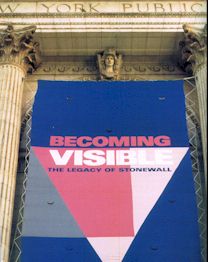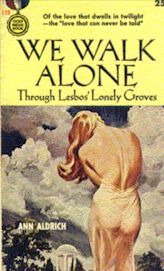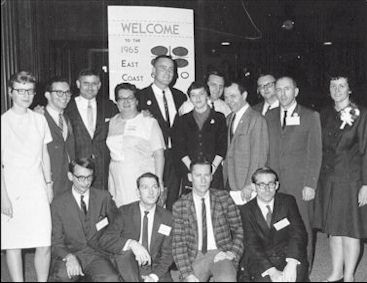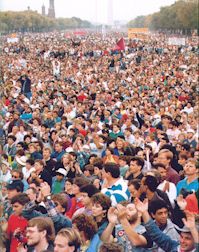 |

 |
|
BookReview By Jack Nichols
Earlier in this decade, in response to Wasserman's request, I'd donated several items to him, including a 1965 letter I'd received from the famed 20th Century philosopher, Bertrand Russell and a copy of the premiere issue of GAY, America's first gay weekly newspaper (1969-73) which I'd co-edited in Manhattan. I'd also supplied the individual names—which, in this book have been sadly omitted in a photo of the group (p. 151)-- to identify national leaders, pioneers of the mid-60s lesbian and gay movement.
These criticisms aside, Becoming Visible, is a classic-coffee-table-must. Its photographs—a mish-mash of curious memorabilia-- leap back excitingly across the 20th century and its flowing text is based on the findings of reputable historians such as John D'Emilio, whose more accurate depictions of our mid-century's gay movement satisfy far greater than do Duberman's. Most valuable are Becoming Visible's plethora of photos of gay males and lesbians at work and at play. Some of these photos, like 1965's White House demonstration, have been published before, but many others have not. History buffs may thrill, for example, to an 1892 drawing (p.105) of the swimming pool at Manhattan's Everard Baths. It had looked much the same in the last century as it did nearly a hundred years later, after wide-eyed psychiatric case books clocked the sexually anarchic atmosphere in which its customers reveled.
We Walk Alone served in its time as a lesbian accompaniment to a similar but more male-oriented tome, The Homosexual in America (1951, by Donald Webster Cory). Queer Patterns, typical of such fiction in its time, ended unhappily: one lover contemplating a vase holding the ashes of the other. Homosexual romance, according to an unwritten early 1950s publishing code, was never allowed to succeed. Becoming Visible begins by telling, once again, the legend of the Stonewall. It quotes pioneering book store owner Craig Rodwell, a dyslexic Christian Scientist, who insists no drag queens were present at the uprising, an observation heatedly countered by others. There is, on page 2, for example, Fred W. McDarrah's famed photo of youths taken at least within the riot's first two days and in which one transgendered person is clearly shown. Section Two, "Sodomites, Perverts, and Queers" discusses the illegal status that all persons capable of same-sex love shared and tells how "Labeling and Policing" techniques became commonplace. There are photos of paddy wagons carting away the customers from staid gay bars in decades past.
Section Three, "Social Worlds" tells—for both women and men—what gay life was like starting in the first half of the century. There are pictures of sailors dancing (1918) of female impersonator Jose Julio Sarria's San Francisco campaign poster (1961) and of the Firehouse in Manhattan where the highly successful Gay Activists Alliance created an uninhibited atmosphere around what became—in the Stonewall era-- Gotham's best-loved dance floor. The last section, "Organizing" uses the above-mentioned White House photo of me, Kameny and Vincenz for its frontispiece. Its text jumps from the 60s into the 90s and is sometimes inspiring. McGarry and Wasserman, for example, say wisely that:
But lesbians and gay men have exhibited extraordinary vitality and endurance. Growing from a small band of homophiles in the fifties, to an army of queers in the nineties, they have built a mass movement for political and social change. And while the other progressive movements of the 1960s and 1970s have waned, the gay rights movement has flourished. In the three decades since Stonewall queers have become an increasingly visible—and vocal—force to be reckoned with, challenging and changing America. |
 © 1997-99 BEI
© 1997-99 BEI
 Becoming Visible 1994 exhibit at the New York Public Library
Becoming Visible 1994 exhibit at the New York Public Library  On page 113, are shown the telling covers of two paperbacks about lesbians. One of these, Queer Patterns (1953) was the very first homosexual novel I read, and the second, We Walk Alone (Ann Aldrich) I distributed among Bethesda-Chevy Chase High School friends in 1955. Since they're no longer in my possession, I'm grateful about the inclusion of these long-ago titles.
On page 113, are shown the telling covers of two paperbacks about lesbians. One of these, Queer Patterns (1953) was the very first homosexual novel I read, and the second, We Walk Alone (Ann Aldrich) I distributed among Bethesda-Chevy Chase High School friends in 1955. Since they're no longer in my possession, I'm grateful about the inclusion of these long-ago titles.

 March on Washington
March on Washington